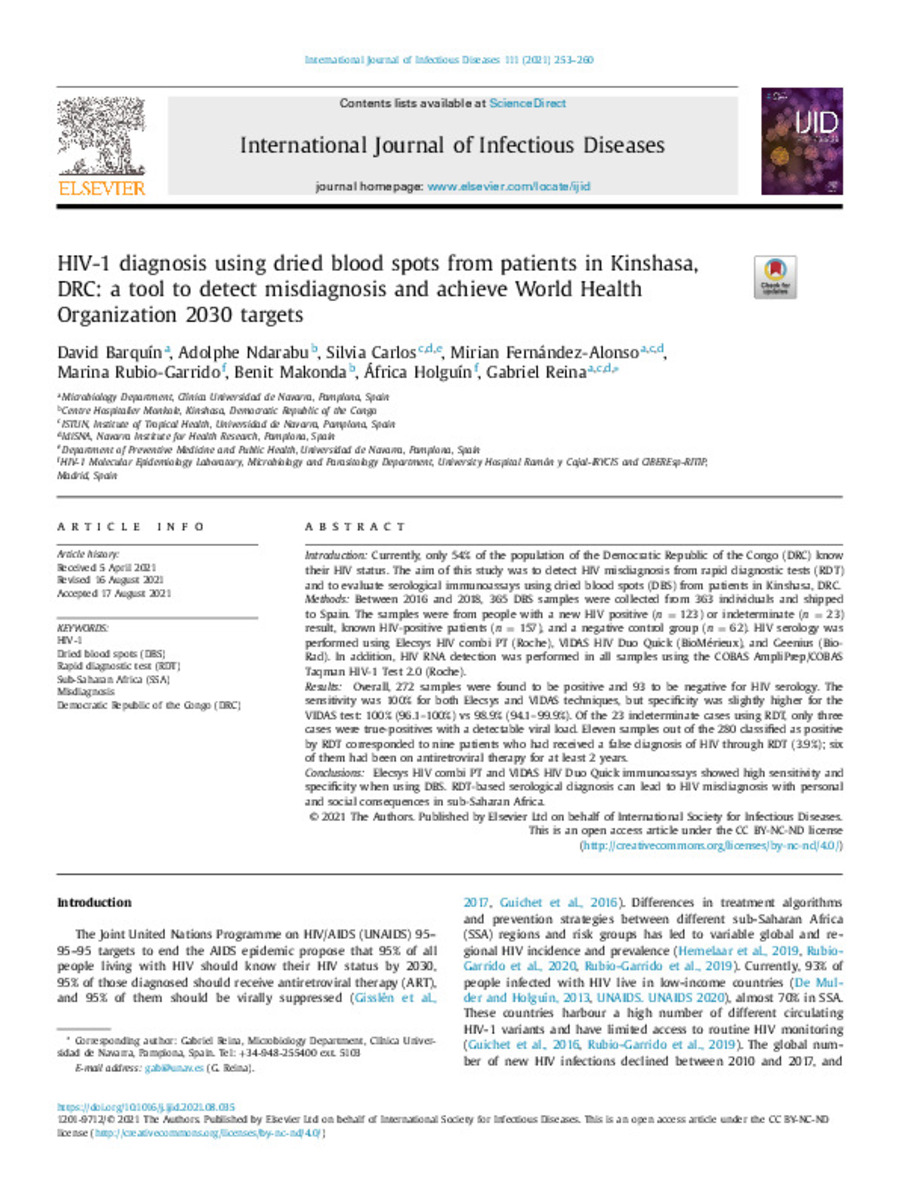Full metadata record
| DC Field | Value | Language |
|---|---|---|
| dc.creator | Barquín, D. (David) | - |
| dc.creator | Ndarabu, A. (Adolphe) | - |
| dc.creator | Carlos-Chillerón, S. (Silvia) | - |
| dc.creator | Fernández-Alonso, M. (Miriam) | - |
| dc.creator | Rubio-Garrido, M. (Marina) | - |
| dc.creator | Makonda, B. (Benit) | - |
| dc.creator | Holguín, Á. (África) | - |
| dc.creator | Reina, G. (Gabriel) | - |
| dc.date.accessioned | 2022-04-06T11:37:12Z | - |
| dc.date.available | 2022-04-06T11:37:12Z | - |
| dc.date.issued | 2021 | - |
| dc.identifier.citation | Barquín, D. (David); Ndarabu, A. (Adolphe); Carlos, S. (Silvia); et al. "HIV-1 diagnosis using dried blood spots from patients in Kinshasa, DRC: a tool to detect misdiagnosis and achieve World Health Organization 2030 targets". International Journal of Infectious Diseases. 111, 2021, 253 - 260 | es_ES |
| dc.identifier.issn | 1201-9712 | - |
| dc.identifier.uri | https://hdl.handle.net/10171/63362 | - |
| dc.description.abstract | Introduction: Currently, only 54% of the population of the Democratic Republic of the Congo (DRC) know their HIV status. The aim of this study was to detect HIV misdiagnosis from rapid diagnostic tests (RDT) and to evaluate serological immunoassays using dried blood spots (DBS) from patients in Kinshasa, DRC. Methods: Between 2016 and 2018, 365 DBS samples were collected from 363 individuals and shipped to Spain. The samples were from people with a new HIV positive (n = 123) or indeterminate (n = 23) result, known HIV-positive patients (n = 157), and a negative control group (n = 62). HIV serology was performed using Elecsys HIV combi PT (Roche), VIDAS HIV Duo Quick (BioMérieux), and Geenius (Bio- Rad). In addition, HIV RNA detection was performed in all samples using the COBAS AmpliPrep/COBAS Taqman HIV-1 Test 2.0 (Roche). Results: Overall, 272 samples were found to be positive and 93 to be negative for HIV serology. The sensitivity was 100% for both Elecsys and VIDAS techniques, but specificity was slightly higher for the VIDAS test: 100% (96.1–100%) vs 98.9% (94.1–99.9%). Of the 23 indeterminate cases using RDT, only three cases were true-positives with a detectable viral load. Eleven samples out of the 280 classified as positive by RDT corresponded to nine patients who had received a false diagnosis of HIV through RDT (3.9%); six of them had been on antiretroviral therapy for at least 2 years. Conclusions: Elecsys HIV combi PT and VIDAS HIV Duo Quick immunoassays showed high sensitivity and specificity when using DBS. RDT-based serological diagnosis can lead to HIV misdiagnosis with personal and social consequences in sub-Saharan Africa. | es_ES |
| dc.description.sponsorship | This study was funded by the Government of Spain (Fondo de Investigación en Salud-FI, grants PI16/01908) and the Government of Navarre (grant 045-2015). | es_ES |
| dc.language.iso | eng | es_ES |
| dc.publisher | Elsevier | es_ES |
| dc.rights | info:eu-repo/semantics/openAccess | es_ES |
| dc.subject | HIV-1 | es_ES |
| dc.subject | Dried blood spots (DBS) | es_ES |
| dc.subject | Rapid diagnostic test (RDT) | es_ES |
| dc.subject | Sub-Saharan Africa (SSA) | es_ES |
| dc.subject | Misdiagnosis | es_ES |
| dc.subject | Democratic Republic of the Congo (DRC) | es_ES |
| dc.title | HIV-1 diagnosis using dried blood spots from patients in Kinshasa, DRC: a tool to detect misdiagnosis and achieve World Health Organization 2030 targets | es_ES |
| dc.type | info:eu-repo/semantics/article | es_ES |
| dc.description.note | This is an open access article under the CC BY-NC-ND license | es_ES |
| dc.identifier.doi | 10.1016/j.ijid.2021.08.035 | - |
| dadun.citation.endingPage | 260 | es_ES |
| dadun.citation.publicationName | International Journal of Infectious Diseases | es_ES |
| dadun.citation.startingPage | 253 | es_ES |
| dadun.citation.volume | 111 | es_ES |
Files in This Item:
Statistics and impact
Items in Dadun are protected by copyright, with all rights reserved, unless otherwise indicated.






